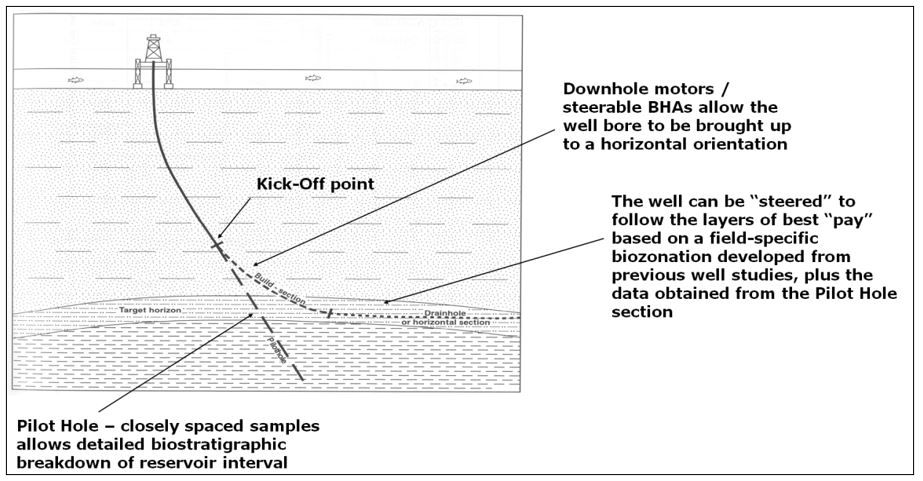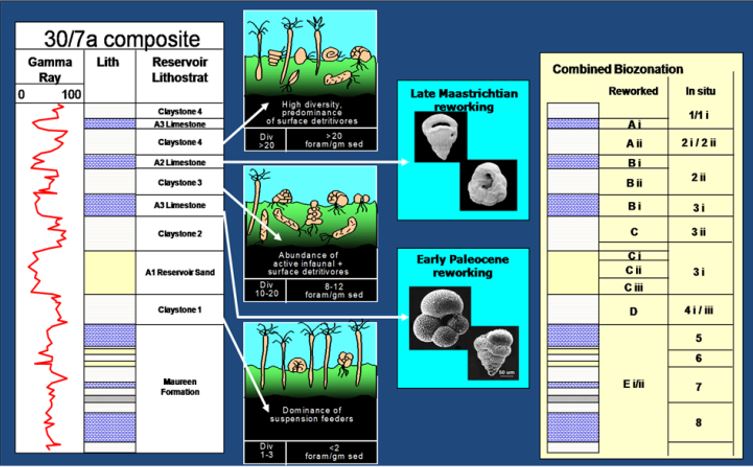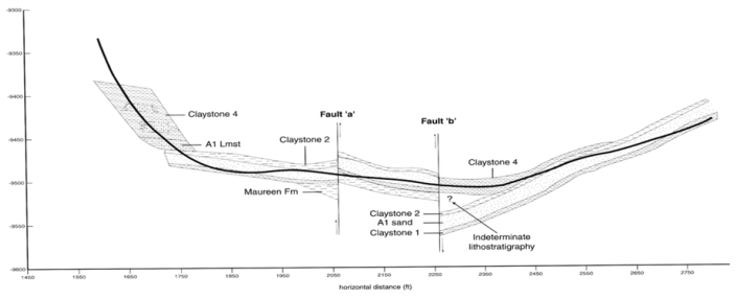Table of Contents
Biosteering
Many reservoirs are best exploited by “horizontal” production wells, as far more of the exposed well bore can be located within the reservoir than can be drilled with “conventional” vertical/subvertical wells. In structurally simple reservoirs it is often enough to set up the wellbore aligned to the correct trajectory and simply drill ahead. However most reservoirs are either structurally more complex, or have internal subdivisions which display variable petrophysical parameters which require either targeting or avoiding. In such cases it is required to frequently change the drilling trajectory in order to remain within the optimum part of the reservoir (sometimes called “chasing the reservoir”).
As part of the practical considerations, it is common to have two wellsite biostratigraphers at rigsite during these kinds of production wells as 24-hour coverage may be required. Each biostratigrapher works an alternate 12-hour shift until drilling is complete. In some circumstances it may be that each biostratigrapher is an expert on different fossil groups to provide as wide a paleontological dataset as possible. This is a situation common in the horizontal drilling strategy of many chalk fields in the North Sea (for example).
Prior to drilling a horizontal production a “pilot hole” may be drilled to provide an opportunity to closely evaluate the vertical distribution of fossils through a reservoir and the rock units both above and below it. Samples can be collected over a closely-spaced interval and a detailed distribution chart can be constructed. This enables individual reservoir units to be “fingerprinted” with a characteristic set of fossils contained within it, together with “marker species” which help to define it.

The basic components of a horizontal production well. With greater familiarity of the field, fewer (if any) pilot holes may be needed.
Joanne Field (UK North Sea) “Chasing the Reservoir”
In the structurally complex Joanne Field of the UK North Sea, Holmes (1999) demonstrated that close analysis of the section reveals in situ claystone layers above and below the reservoir sand unit (which in itself is relatively unfossiliferous) which are separated by limestones containing re-worked older microfossils. Each unit can be fingerprinted by its specific type of in situ or re-worked component. A “combined biozonation” of in situ and re-worked forms can be constructed for the succession.
During the drilling phase it can be seen that the well bore exited the reservoir on several occasions and that the wellsite biostratigraphic determinations allowed the well trajectory to be adjusted in order to re-acquire the reservoir as quickly as possible. In this very complex reservoir setting the well bore did not remain within the reservoir for very long before the next exit, however, the total percentage of borehole length within the reservoir by the time TD was reached was still very much more than was expected than by drilling without the use of wellsite biostratigraphy.

Biozonation and events used on the Joanne Field (Holmes, 1999). The zones comprised intervals of in situ and reworked microfossils, each having slightly different compositions to allow correct identification.


Two wells illustrating the complexity of the Joanne Field and the well trajectories “biosteered” to maximise exposure to the reservoir interval. Biostratigraphy allowed to quick return to the reservoir after frequent exits due to dip changes or structural features such as faults.
Because wellsite biostratigraphy was shown to be an effective tool at maximising reservoir exposure, the production strategy for the field was changed from plans to drill 16 conventional wells, to 9 “horizontal” wells resulting in an overall estimated saving of $12 million.
